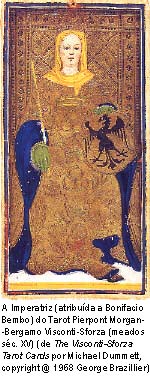| What
is the Tarot? |
|
The Tarot is a 78 ilustrated and numbered deck of cards which
is divided in Major Arcana (22 cards) and Minor Arcana (56 cards),
these being frther divided in Court cards (16) and Pips (remaining
40 cards). Arcana is a latin word meaning ancient knowledge, hidden,
secret.
|
Where does the Tarot come from?
|
|
Nobody knows for sure who, when or how the Tarot came to be.
Many myths, spread by pseudo-experts in a number of books, link
the Tarot to Ancient Egypt as the scenario for the creation of
this deck. Others mention Gipsies, Atlantis, Babylonia, etc, etc.
The origins of the Tarot are indeed wrapped in a certain mistery,
but not *that* much.
The first known reference to a Tarot deck comes from the end
of the XIV century, where a monk or priest writes about a deck
used in a very popular game called carte da trionfi, Trump
Cards. This reference is later confirmed by the discovery of the
first Tarot deck, incomplete, from XV century Italy. The name
of the cards was later changed during the XV century to Tarocchi
(sing. Tarocco) to distinguish them from another game of
Trumps that was very popular then, played with regular playing
cards.
 Until
the mid XVIII century the Tarot was used like a regular deck of
playing cards, very popular among all classes of society, The
rules of that game survived to this day, and can be found here.
In the XVIII, french and english occultists "found"
the Tarot, proclaiming this deck to be a mystic and magical key
to life, the universe, and everything. The Tarot began to be used
for divination and magical practices, e all it's symbolism took
on a new dimension as new decks were created according to the
beliefs and knowledge of these scholars. Until
the mid XVIII century the Tarot was used like a regular deck of
playing cards, very popular among all classes of society, The
rules of that game survived to this day, and can be found here.
In the XVIII, french and english occultists "found"
the Tarot, proclaiming this deck to be a mystic and magical key
to life, the universe, and everything. The Tarot began to be used
for divination and magical practices, e all it's symbolism took
on a new dimension as new decks were created according to the
beliefs and knowledge of these scholars.
|
The Rider-Waite (or Smith-Waite) Tarot
|
|
In the first decade of the XX century, R. W. Waite created an
innovative deck. All decks before his only had pictures in the
Major Arcana, the Minor Arcana depicting solely the symbols of
the suit, the same way as regular playing cards. Waite's innovation
was to create, for each of the Ace to 10 cards of the 4 suits,
a different illustration depicting the meaning of the card. The
author of these illustrations was Pamela Coleman-Smith, an astonishing
artist who transformed Waite's sparse directions into inspired
works of art which took the worl of Tarot by storm. With these
new illustrations filled with symbolism, it was no longer necessary
to stick with the memorized meanings of the cards. The reader
could now, in his(her) readings, free the imagination to endless
peaks of inspiration with these cards.
The deck that Waite and Smith created is called Rider-Waite (Rider
was the publishing house that produces the deck, or Smith-Waite,
in homage to the artist. The RW created a whole school of Tarot,
and it is the recommended deck for a beginner; for starters, it's
symbology owes a lot to the classical decks, and the pips' overall
is a tremendous help in readings. Overmore, the great majority
of modern decks is based on this and other decks following similar
lines (the Golden Dawn), so this deck forms a very solid base
of knowledge, from which one can learn and apply this learning
to other decks with ease.
|
|